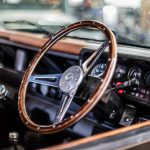1986 Porsche 911 Overview
The 1986 Porsche 911 embodies the classic spirit of Porsche’s iconic sports car lineage, offering a combination of exhilarating performance, timeless design, and race-bred engineering. Known for its rear-engine configuration and distinctive styling, the 1986 911 continues to uphold the legacy that began in the early 1960s. By 1986, the 911 had been refined and modernized while staying true to its roots, making it one of the most desirable sports cars of its era.
Design and Exterior
The 1986 Porsche 911 retains the unmistakable shape that has defined the model for decades—rounded fenders, a sloping roofline, and a distinct rear-engine profile. Its classic proportions and aerodynamic lines make it instantly recognizable as a 911, while subtle updates give it a modern edge for the mid-1980s. The 911’s wide wheel arches and aggressive stance hint at its performance capabilities, and its compact yet muscular silhouette remains a symbol of Porsche’s design philosophy.
One of the 911’s signature design elements is its round, upright headlights, which have been an iconic part of the car’s aesthetic since its inception. For 1986, the 911 was offered in several striking paint finishes, including Porsche’s signature Guards Red, Black, and Grand Prix White, as well as more subdued metallic hues like Meteor Grey and Venetian Blue.
Interior and Features
Inside, the 1986 Porsche 911 is a driver-focused cockpit, offering a blend of functionality and luxury. The cabin is compact but comfortable, with supportive, leather-trimmed bucket seats designed to hold the driver and passenger securely in place during spirited driving. The dashboard layout is straightforward and clean, with a simple, analog instrument cluster featuring Porsche’s traditional five-gauge design, with the prominent tachometer placed front and center.
Standard interior features for the 1986 911 included power windows, air conditioning, and a premium Blaupunkt sound system, though most enthusiasts are drawn to the pure driving experience the 911 offers. While it may not boast the plush luxury of a grand tourer, the 911’s interior is all about delivering a connected, visceral driving feel. Its rear seats, like those in the 928, are small and better suited for extra storage or occasional use, maintaining the car’s 2+2 configuration.
Engine and Performance
The 1986 Porsche 911 is powered by a robust 3.2-liter flat-six engine, an air-cooled unit that is synonymous with the 911 model. This naturally aspirated engine produces 207 horsepower and 192 lb-ft of torque, providing the car with spirited acceleration and a thrilling top-end rush. Paired with either a 5-speed manual G50 transmission or an optional 4-speed Sportomatic, the 911 delivers a driving experience that is both engaging and rewarding.
The 3.2-liter engine features Bosch fuel injection for improved efficiency and throttle response, which, combined with the car’s lightweight construction, allows the 911 to achieve 0 to 60 mph in just over 6 seconds. The top speed of the 1986 911 is an impressive 149 mph, making it a serious contender on both the street and the track.
The 911’s rear-engine, rear-wheel-drive layout gives it a unique handling characteristic, often described as “lively.” Enthusiasts appreciate the car’s ability to reward skilled drivers with precise control and feedback, especially through challenging corners. Porsche’s suspension tuning, combined with wider rear tires, helps to mitigate oversteer and provides exceptional road grip.
Technology and Innovations
For 1986, the Porsche 911 continued to benefit from incremental technological advancements that improved performance and safety:
- Bosch Motronic Fuel Injection: Improved fuel delivery and efficiency, contributing to better throttle response and lower emissions.
- Power-assisted disc brakes: Offered strong stopping power with excellent pedal feel, helping drivers maintain control during high-performance driving.
- Optional Limited-Slip Differential: Enhanced traction and stability during aggressive cornering, a highly sought-after option for track enthusiasts.
Though the 911 lacked some of the advanced electronic systems that would appear on later models, its simplicity was part of its charm, offering an undiluted, mechanical driving experience.
Driving Experience
Driving a 1986 Porsche 911 is a unique and rewarding experience, offering a balance between raw performance and refined handling. The rear-engine layout gives the car its distinctive feel, with a weight distribution that provides excellent traction at the rear wheels, especially under acceleration. The steering is direct and communicative, giving the driver an intuitive connection to the road.
The 5-speed manual transmission is praised for its crisp shifts and precise feel, while the flat-six engine delivers a distinct, throaty exhaust note that has become a trademark of the 911 experience. On winding roads, the 911 is agile and responsive, with its compact dimensions making it easy to maneuver through tight corners. However, the car also excels as a high-speed cruiser, with a smooth ride and enough comfort to handle long-distance drives.
Legacy and Collectibility
The 1986 Porsche 911 remains a highly desirable model among collectors and driving enthusiasts. The Carrera 3.2 era (produced from 1984-1989) is particularly celebrated for its robust engineering and reliability, marking the last of the fully air-cooled 911s before the introduction of the water-cooled models in the late 1990s. As a result, 1986 911s are often regarded as some of the most reliable and drivable classic 911s available.
With its timeless design, rewarding driving dynamics, and mechanical purity, the 1986 911 is a benchmark for classic sports cars. Well-maintained examples, especially those with the desirable G50 manual transmission, can command high prices on the collector market. Whether as a weekend driver or a long-term investment, the 1986 Porsche 911 offers enduring appeal and continues to be one of the most sought-after models in Porsche’s storied history.


